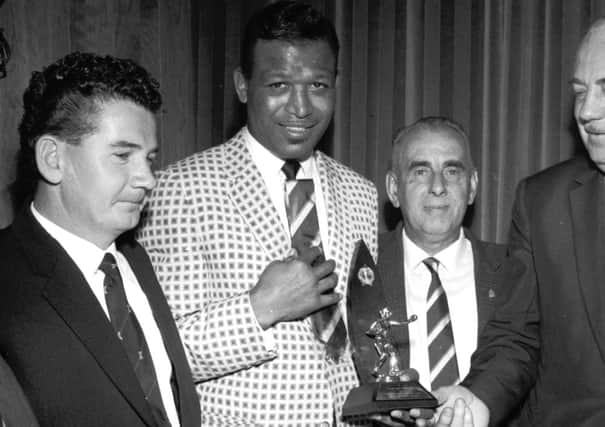The day Sugar Ray Robinson left Scots starstruck


You could claim that there was something symbolic about the appearance of the fabled Sugar Ray Robinson at Edinburgh City football club’s newly-opened social club 50 years ago in August 1964.
Edinburgh City had once been a fixture in the country’s top leagues and, in 1937, had shocked Hibs by beating them by 3-2 in the Scottish Cup at Easter Road. But in 1964, City were a club in name only, having neither team or stadium.
Advertisement
Hide AdAdvertisement
Hide AdSimilarly, the impressive figure dressed in an eye-catching houndstooth jacket who had agreed to open their new social club in Baxter’s Place at the top of Leith Walk was, like Edinburgh City, living on memories of better days – though in his case, his status as a former five-time world middleweight boxing champion was somewhat more illustrious.
The man voted the greatest pound-for-pound boxer of all time was photographed by The Scotsman pulling the very first pint of beer drawn from the social club’s bar taps.
As a token of their gratitude, Robinson was presented by Edinburgh City officials with a plaque and made an honorary social club member. Meanwhile, in a gracious speech of thanks, Robinson acknowledged that there were not many football teams in New York’s Harlem where he resided. His lack of familiarity with the sport had already been made apparent when Rangers invited Robinson to Ibrox to take in their home clash with Dunfermline. Prior to kick-off Sugar Ray had failed to make contact with a ball thrown for him to kick in front of 40,000 fans.
The trip to Ibrox a few days before his Edinburgh appearance was all part of a campaign by Glasgow boxing promoter Peter Keenan to hype a non-title ten-round clash between Robinson and Coventry-based British middleweight champion Mick Leahy – scheduled for 3 September in Paisley.
However, boxing royalty did not come cheap, as Keenan explained in a 1991 interview. Even though Robinson had ditched the huge entourage that he had previously brought to Britain in July 1951 when defending and losing his world title in London against England’s Randolph Turpin, Keenan recalled: “It still cost me £500 per day to put Robinson, his manager and a secretary up at Giffnock’s McDonald Hotel.”
Among those awaiting Robinson’s plane when it touched down in Prestwick airport was The Scotsman’s illustrious sportswriter, John Rafferty, who wrote: “It is surprising, after so much adulation and high life at the top, that he [Robinson] should be so pleasant, natural and interested in people.’’
Promoter Keenan tried to maximise this charismatic effect to boost the Paisley fight gate. Robinson was photographed playing with £400 of chips in Glasgow’s St Tropez casino; he also hammed it up with Celtic players making a recording of The Celtic Song to balance out his visit to Ibrox.
The American ring legend hit it off with Hamilton’s future world flyweight champion Walter McGowan, who recalled: “Sugar Ray was a fabulous guy, great company – but I saw first hand, in Hamilton’s Parochial Hall where he was sparring, the ruthlessness that made him such a great champion.’’
Advertisement
Hide AdAdvertisement
Hide AdMcGowan added: “Robinson was sparring with a Jamiaican Commonwealth Games middleweight gold medal winner called Milo Calhoun. Calhoun caught Sugar Ray with two tasty body shots and Robinson then simply knocked him down to show who was boss.”
His opponent in Paisley, Leahy, was born in County Cork, one of a family of 16. Leahy had only lost 15 out of 150 amateur bouts and had beaten Englishman George Aldridge (who had defeated Scot John “Cowboy’’ McCormack) for the British middleweight crown that Leahy now wore.
The Irishman had also given up his Irish citizenship for British nationality in order to win the British title.
His manager George Middleton had also guided Turpin to that huge upset win over Robinson for the latter’s world middleweight crown, and many thought he might be a secret weapon in the Irishman’s camp.
One Scottish boxing scribe questioned, pre-bout, if Robinson’s age of 43 would be the decisive factor in helping Leahy to beat the American ring legend.
A capacity crowd packed in to see if Robinson could reproduce some of the magic that had brought him one world welterweight title and five world middleweight crowns between 1951-60.
During the fight, Robinson showed flashes of the old greatness, although Leahy caught him with good punches in rounds three and seven. It became clear to those sitting ringside that Robinson could still execute the odd move of exquisite class. His boxing brain was still sharp, but the message took too long to get to his gloves.
Welsh referee Ike Powell was clearly in agreement with that assessment as he scored the contest for Leahy – whom he saw as a clear winner after ten rounds, much to Robinson’s disgust.
Advertisement
Hide AdAdvertisement
Hide AdIt was a verdict that the promoter Keenan also disagreed with, saying: ‘’I honestly thought that Sugar outboxed Leahy.”
Middleton, having played a key role in engineering two UK defeats for Robinson, was less generous, stating: “Take away the sentimentality and what is left of Robinson?’’
After his defeat in Scotland, Sugar Ray only fought twice more before bowing out in a glittering farewell event at Madison Square Garden, New York on 10 December 1965. He retired with a record of 173-19-6 (two no contests) with 108 knockouts in 200 professional bouts.
While a shadow of his former self during that Edinburgh bout half a century ago, Robinson, who died in Los Angeles in 1989, nevertheless retained the admiration and respect of the Scottish crowd.
Leahy never won another bout, losing his British title in December 1964 before he was forced to quit after losing the sight in his left eye as a result of a car crash in 1965.